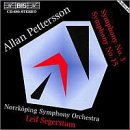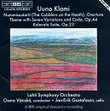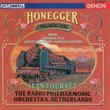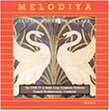| All Artists: Allan Pettersson, Leif Segerstam, Norrköping Symphony Orchestra Title: Allan Pettersson: Symphonies Nos. 3 & 15 Members Wishing: 2 Total Copies: 0 Label: Bis Release Date: 7/18/1995 Album Type: Import Genre: Classical Styles: Historical Periods, Modern, 20th, & 21st Century, Symphonies Number of Discs: 1 SwapaCD Credits: 1 UPC: 789368210527 |
Search - Allan Pettersson, Leif Segerstam, Norrköping Symphony Orchestra :: Allan Pettersson: Symphonies Nos. 3 & 15
 | Allan Pettersson, Leif Segerstam, Norrköping Symphony Orchestra Allan Pettersson: Symphonies Nos. 3 & 15 Genre: Classical
|
Larger Image |
CD DetailsSimilar CDs
|
CD ReviewsPettersson 15th: an absolute masterpiece 06/14/1999 (5 out of 5 stars) "I have listened all the Pettersson's symphonies: but the first I listened, the 15th, is peraphs the only one, for me, to present a characterization of absolute masterpiece. The symphonic language of Pettersson is not "thematic", where you can recognize a thematic line the music provides often to take you elsewhere. But here try to believe in the melodic refrains, such as desperate links with human capability to still "feel" something upon the rhythmical outburst of adversities; you'll have experience of an incredible depth of musical conception, in his phonosymbolic power and evocation. This is the better recording of the symphony, in my opinion. Roberto Ranieri" WHO IS GUSTAF ALLAN PETTERSSON? Duane E. Crawford | Rolette, ND USA | 08/19/2002 (4 out of 5 stars) "Before I went to a Pederson Reunion in SD, I ordered Symphony 3 and 15 by Pettersson because I wanted something for the family and Segerstam had conducted it. It took Arkiv finally to come up with it. Pettersson I find was from a harsh family that he escaped from with the violin. He had arthritis so bad someone else had to sketch out many of his later concertos and symphonies, of which I believe there were sixteen symphonies. I greatly prefer three to fifteen. Like Sibelius Pettersson starts with motifs that he finally brings into coherence. Fifteen is too harsh for my eardrums. I'd like to try some of the [$$$] Pettersson symphonies. Segerstam's THOUGHTS I found to be pretty fair. In my country fair means good; we never say excellent." Darkness at daybreak; darkness at evening Daniel R. Greenfield | Milwaukee, Wisconsin, United States | 12/08/2001 (4 out of 5 stars) "This disk contains two important works from Pettersson's early and late periods. Although the middle symphonies (Fifth through Ninth) are widely considered his greatest, this disk shows that Pettersson possessed the rare gift of musical genius throughout his whole career as a composer. Both the Third and the Fifteenth also show the manner by which his works fell into that dark and obscure world for which they were destined: The Third, dating from 1955, was ignored by the Stockholm Concert Society for about four years until they finally deigned to perform it in 1959. And the Fifteenth did not receive its initial premier until 1982, more than two years after the composer's death.
He long considered the Third to be his best work. The influence of Sibelius is obvious in spots, combined with P's enduring penchant for creating dark, somber soundscapes, oftentimes jarringly dissonant. Though it is in four movements, there is no actual break between the last three. The fourth movement is particularly impressive, as out of dark obscurity a beautiful lyric slowly begins to emerge on the flute at the conclusion of the work. The strings restate this gently haunting refrain in the face of several false endings. Finally the lower woodwinds speak up, ending the work on a curt three-note phrase, dark and cryptic. The Fifteenth shows Pettersson still at the height of his powers, a master of the orchestral palette. It begins as a work of "hardened diction", abrasive, troubled, with ever-present militant snare-drum and clashing cymbals. Yet there is also a sense of mission. There seems to be an earnest desire to carve a meaning out of the darkness, and to move toward some redemptive inner vision. The work concludes with a prolonged chorale of raw beauty painted with long broad brushstrokes, mildly dissonant yet occasionally breaking into some really beautiful harmonics. Struggling toward some inner light, the work ends with an urgent and prolonged chord on the higher strings, as the light is finally seized, however briefly." |

 Track Listings (5) - Disc #1
Track Listings (5) - Disc #1



